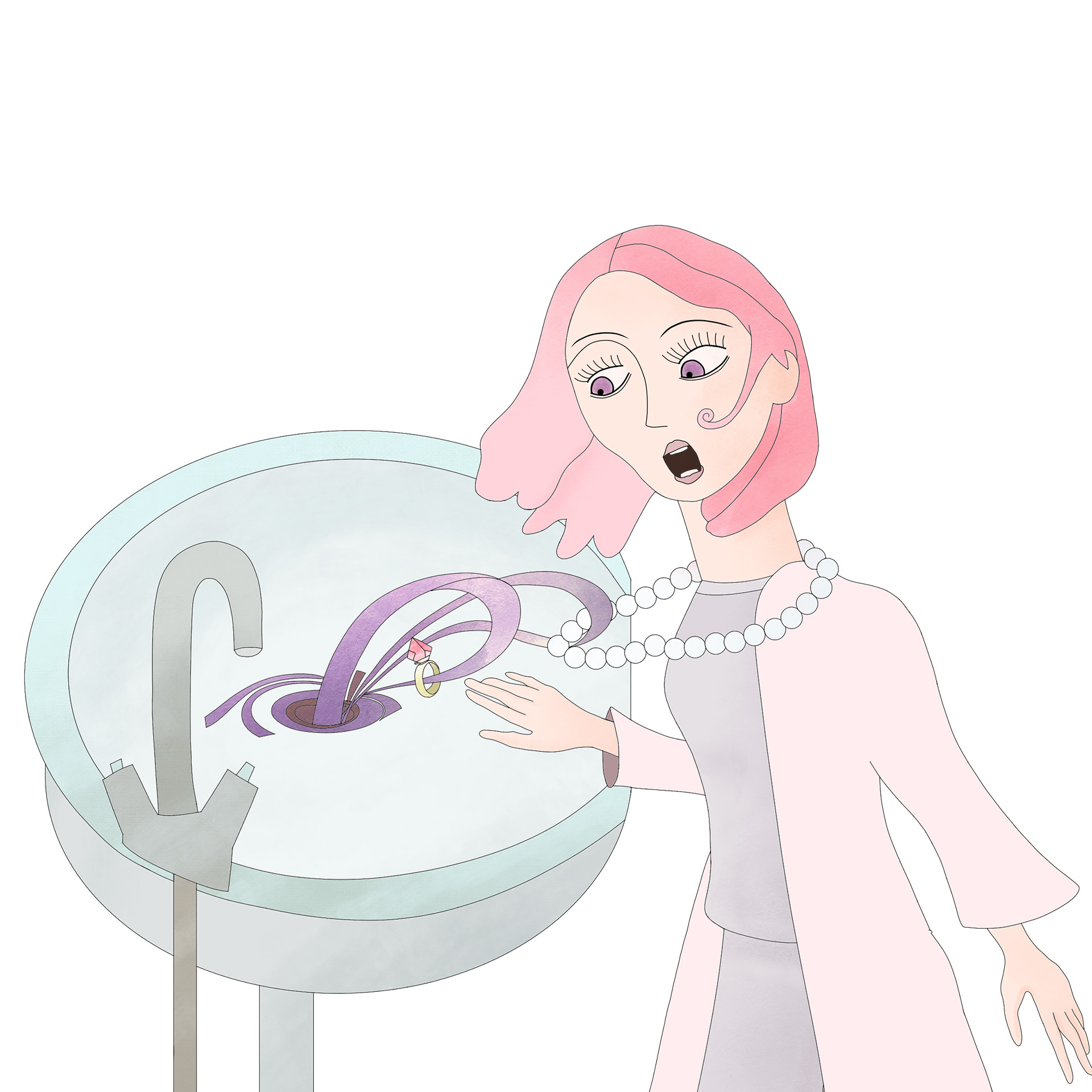An intimate look into the life of atelier’s behind the scenes
Wear and tear is an inevitable part of the life of a jewel. Even if you maintain it and clean it regularly at home, you will still benefit from taking your jewel to a professional every few years.
Any jeweller worthy of their name will offer you a variety of services to help you enjoy your jewels at their best. Professional goldsmithing services are not necessarily to be assimilated with a talent for creative design.
Goldsmithing is based on knowledge, technical skills and experience. This guide is about what services to expect from a skilled goldsmith and how to build a professional relationship with them over time.
On The Topic Of Trust In The Jewellery Industry
In the jewellery industry trust is the sun. It can be an unnerving experience to search for a new goldsmith to trust your jewels or a special order with for the first time. Reputation, craftsmanship, references, and character are of the utmost importance. Ideally, you should establish a long-term relationship with a jeweller, based on transparency and results. We advise you to start with smaller tasks to ensure your jeweller is capable, before entrusting them with your precious heirloom jewels.
A good service to start with is to ask for a cleaning and polishing with mirror finish. Although seemingly simple, creating a mirror-like finish on a jewel can truly reveal a goldsmith’s savoir-faire. Only after you have determined the quality of your goldsmith’s work should you consider collaboration on more valuable pieces. However, you need to fill in all the relevant paperwork, before any work has begun. It is a crucial first step that sets an atmosphere of transparency and trust.

Jewellery Diagnosis & Paperwork
When a goldsmith is asked to provide any kind of service for a jewel the first thing he needs to do is to get to know the piece. Different metals and gems cannot all be treated the same way.
Standard jewellery repair form
Normally, your jeweller will note down the date, your contact details, the technical description of your jewel, and what service needs to be done. It is a good practice to go through the identification process of the jewel together with your jeweller to be sure you are both on the same page as to what the metals and gems are.
Jewellery repair diagnosis
With the help of a loupe, the jeweller will go through the analysis of the jewel and write the findings down on the form. You should be shown what needs to be repaired through the loop if not visible with the eyes. If the jeweller is tech-savvy he may be able to provide you with a microscopy image for the harder-to-spot areas to repair. The procedure may take time as professional jewellers prefer to be thorough in their examination. Nobody likes to call their clients with the bad news of unexpected additional damages and costs.
Security documentation for jewels
In the absence of a long-term working relationship with a jeweller, legal security becomes much more important. Trust is a two-way street, especially when it comes to working on rare and valuable jewels. Just like you might be worried about your gemstones being switched, so do jewellers worry about being wrongfully accused. Diligent jewellers may even ask you themselves for an appraisal of your jewellery coming from a gemologist or an independent third-party expert beforehand. This ensures an unbiased identification of the components of your jewel.
Before you leave your jewel in a goldsmith’s atelier you should have agreed on the identification of the jewel, the procedure that needs to take place, and the price. This will all be reflected in the jeweller’s take-in form. They will provide you with a duplicate of the form that must be signed and stamped. The independent appraisal and the take-in form serve as your legal security. Once the work has been completed and you are happy with the results, you will mark and sign the jeweller’s form to confirm that it was returned to you on a specific date in the condition that you wanted.
If you would like to reach out to one of our dedicated partners for a professional appraisal of your jewel, our team is happy to help. Just contact us anytime.

Polishing Jewellery To A Mirror Shine Finish

Find out more about how to clean gems in our free digital jewellery maintenance kit.
The mirror shine polish is one of the most common requests at goldsmithing ateliers. As we already mentioned it is a task that can reveal the true skills of your goldsmith. Polishing jewellery is a simple but lengthy process that requires skill, patience, and multiple tools and techniques to be done properly.
Throughout the years your jewels inevitably become worn out. Scratches may appear, dirt will accumulate in the setting, and your jewel will lose its once bright shine. Nothing will bring back the glory to your jewel, like a mirror-like polish.
However, beware that every time your jewel is polished, a thin layer of its surface is removed. When done excessively, this will eventually weaken your jewel and cause it to bend or break. Expert jewellers recommend not having a fine jewel polished more than 3 times in its lifetime.
A great polish consists of three main steps – sanding, polishing, and cleaning. We’ve also added a few optional and alternative steps – filing, burnishing, thread polishing, and cleaning with Rhodium.
1. Sanding
If your jewel has strong markings such as scratches it will require to be sanded before being polished. During the sanding process, jewellers use sandpaper or professional sanding sticks with grits starting at 320 and up to usually 600 to work on the surface of your jewel.
This will remove a thin layer of the metal long with all its markings and make the polishing more effective. Sometimes jewellers opt to work through even finer grits up to 1200 for the so-called “near finish”. This sandpaper surface is extremely fine and smoothens the surface of your jewel in such a way that requires little polishing afterward.
Burnishing is an ancient method, defined as ‘the plastic deformation of a surface due to sliding contact with another surface’. It can be preferred to sanding because it does not remove layers from the metal, it simply reshapes it. If your jewel is already too thinned out from frequent sand polishing, you should consider this method. It is also safer for tightening and polishing the edges of a bezel setting.
Burnishing can be done by hand with jewellery burnishers or by placing a jewel inside a magnetic tumbler. The tumble has small pearls or metal pins that are harder than your jewel with soapy water. Then it mechanically rotates at a high speed until the metal is smooth and shiny again.
2. Polishing
The next step towards the mirror-like finish is the process of polishing. Sometimes a pre-polishing mixture like Tripoli is used as a first buffer. Afterward, jewellers use various grease compounds that are mildly abrasive. They apply these compounds to polishing tools like mops, brushes, wheels, and points. All the compounds vary in coarseness and are used at high speeds.
Depending on the condition and the composition of the jewel, the jeweller uses specific combinations of tools and grease compounds. A variety of brushes will be used to remove scratches, markings, and imperfections starting from the strongest and ending with the softest. This process leaves only the original smoothness and shininess of your jewel’s surface.
Every goldsmith will have their secret mix for a mirror finish. One trick lies in the overlying directions of the polishing brushes. For example, a jeweller might polish the jewel in two or more directions at a specific angle for each brush used. The combinations of grease compounds are equally important and are specific to their metal composition.
This last step is skipped by most but thread polishing is a sign that your jeweller is a perfectionist. Certain inside areas of a jewel can be impossible to reach with the mechanical polishing brushes. They will therefore not only remain unpolished but will often still have excess grease compound remaining from the mechanical brush polish. A distinguished jeweller will thread polish the inside of a setting by hand with jauned (“jaune” compound grease) cotton threads.
3. Cleaning
The last step to the mirror-like finish is to properly clean the jewel. After polishing the jewel will often still have traces of the polishing grease compounds. The cleaning method depends on the settings, finishes, and gems in your jewel.
Although the cleaning techniques that are used professionally and at home can be similar, your jeweller has professional-grade technology and years of experience. Certain jewellers develop their own tips and tricks. Some will dabble with chemistry and carefully create their own blends of cleaning products adapted to each type of gem.
Rhodium is a precious metal and its colour is easier to control than mixing alloys especially when it comes to white gold. That’s why Rhodium is often used to plate gold settings. These rhodium platings will fade with time and let the original gold colour appear through patches. Naturally, if a jewel is polished the plating disappears completely. Therefore, having your jewels re-plated with rhodium is often a last step of the professional clean and shine at a jeweller.
Polishing can reveal defective jewels ,In some particular cases, polishing can do more harm than good. One example is when the casting of a jewel was done poorly as a result of an error in vacuum or temperatures during the casting process of a new metal setting. Such a setting is considered defective. Polishing it will actually reveal small bubbles that have resulted from these casting errors.
The second case is when a jewel is micropavé and the setting was done poorly. Micropavé means that the jewel is covered with tiny gemstones, usually diamonds, set under the microscope with mignature prongs. If the gemstones are set poorly, many will fall out during the polishing process and the jeweller will not have to reset the gems. Needless to say that competent jewellers will not let defective pieces come out of their atelier if they were the ones manufacturing them. Such pieces are mostly the result of low cost, fast or mass production.
What Do Standard Professional Jewellery Maintenance Services Include?
Once you know you can trust a jeweller and you have experienced their quality of work, you may want to consider another service. There is a lot that your jeweler can do for you and your jewels besides cleaning and shining them.
Common repairs
Jewellers will often be able to do most gold and platinum damage repair, prong and bezel repair, loose stone resetting, or missing gemstone replacement without an issue. Rebuilding, reshaping, or replicating entire settings and refinishing metal surfaces are all tasks that a talented jeweller will be able to do for you.
Specialty work
As one cannot specialise in everything, when it comes to special finishes, techniques or metals you will want to go to a goldsmith experienced in the type of work you need done. For example, filigree or enamel, or titanium jewellery, etcetera. Even restringing pearls and beads is an art in itself.
Vintage and antiques
Just like special finishes, restoring vintage or antique jewellery requires specialist knowledge on techniques and finishes that were used at a specific time. It also requires professional equipment to keep a jewel as authentic as possible. Laser technicians will know how to repair certain metal damages without removing stones.
Adjustments services
This service will allow you to enjoy your jewels with maximum comfort. Sometimes a jewel just doesn’t quite fit, here is a list of adjustments you may wish for:
- resizing
- made to measure castings (in case resizing is not possible)
- fitting and soldering sets (ex: bridal sets together, or charms on a chain)
- inside ring springs
- sizing beads
- furnishing expandable shanks for hands suffering from arthritis
- removing or adding components to a chain
- adding safety catches or safety chains
Personalisation services
When you want to make your jewel unique and truly yours or tailored for that special someone A shortlist of personalisations you could have done on your jewel:
- custom engravings
- replacing cords
- changing the tone of gold/ making two-tone and tri-color gold
- adding a gem inside a band or at the back of a jewel
- changing closing systems, caps, bails…
- replacing gems with birthstones or upgrading gems

Where To Go When You Need A Professional Jewellery Service
Finding the right jeweller to work with can be very unnerving as you are often risking damage to your jewels. Reason for which it is always a good idea to ask experts for advice. Professionals have a wide network of connections with various services which can be at your service.
Working with goldsmithing ateliers
If you are able to establish a contact with an esteemed goldsmithing atelier it can be a solution to all of your jewellery problems. However, it’s a challenge to do so because most ateliers prefer to only work within the industry and not with private clients. Another caveat is that they usually do not care for showmanship. Behind the scenes it is all business.
Large goldsmithing ateliers have multiple specialities in-house. Moreover, they have trustworthy contacts throughout the jewellery industry. They work with selected professionals, to whom they can outsource speciality work if they cannot do it in-house. This spares you the entire process of looking for someone new and wondering if they will get the job done right.
It all depends on the jeweller’s skills
At the end of the day, goldsmithing is a craft. The quality of the goldsmithing service will hugely depend on the skills, experience and knowledge of the goldsmith. This means that choosing the right jeweller will have the biggest impact on the end results. Once again, we emphasize the importance of trust between you and your jeweller. Excellent reputation, craftsmanship, references, and character are all defining characteristics of a trustworthy jeweller. If you are not sure about a jeweller, consider working with someone else.
As part of our client care system, we have developed a set of made to measure services for our beloved clientele. We count with the highest quality artisanship of Antwerp, Belgium where we are based. Discover our private atelier services today
Illustration & editorial by Daniel Román
We hope you’ve enjoyed this article and found it useful. This is the third instalment of the Only Jewels 3 part guide concerning jewellery care.
- An Expert Jeweller’s Advice for Cleaning Jewels Safely at Home
- How To Keep Your Jewels Safe To Ensure Their Longevity?











